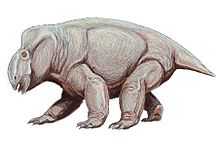Placerias
| Placerias Temporal range: Late Triassic,
| |
|---|---|

| |
| Skeleton | |
| Scientific classification | |
| Kingdom: | |
| Phylum: | |
| Class: | |
| Order: | |
| Suborder: | |
| Infraorder: | |
| Family: | |
| Genus: | Placerias
|
| Species | |
|
P. gigas | |
Placerias (meaning broad body)[1] was a dicynodont (a group of mammal-like reptiles) that lived during the late Carnian age of the Triassic Period (221-210 million years ago). It was a member of the family Kannemeyeridae, the last known representative of the group at this time: the dicynodonts went extinct shortly afterwards.
Description

This animal was the biggest herbivore of its time, measuring up to 3.5 metres (11 ft) long and weighing up to a ton (907 kilograms)[2]. with a powerful neck, strong legs, and a barrel-shaped body. There are possible ecological and evolutionary parallels with the modern hippopotamus, spending much of its time during the wet season wallowing in the water, chewing at bankside vegetation. Remaining in the water would also have given Placerias some protection against land-based predators such as Postosuchus. Placerias used its beak to slice through thick branches and roots with two short tusks that could be used for defence and for intra-specific display.
Discovery

Fossils of forty Placerias were found near St. Johns, southeast of the Petrified Forest in Arizona. This site has become known as the 'Placerias Quarry' and was discovered in 1930, by Charles Camp and Samuel Welles, of the University of California, Berkeley. Sedimentological features of the site indicate a low-energy depositional environment, possibly flood-plain or overbank. Bones are associated mostly with mudstones and a layer that contains numerous carbonate nodules.
It was originally considered the last of the Dicynodonts, but recent fossil finds from Queensland revealed that the Dicynodonts actually survived until the Early Cretaceous.
In popular culture
To date, Placerias has appeared in one television documentary, Walking with Dinosaurs. Alluding to the Placerias fossils found in 1930, these Placerias were shown living in what would one day become the Petrified Forest. They grazed on ferns and dug for roots and tubers with their tusks; they were also shown coming down to a riverside to drink. They were the chief prey of the apex predator Postosuchus. In another scene, forty Placerias were shown migrating to find another source of water; none survived.
See also
References
- ^ Paleofile. "Page on Placerias". Retrieved 20 February 2010.
- ^ Gaines, Richard M. (2001). Coelophysis. ABDO Publishing Company. p. 19. ISBN 1-57765-488-9.
{{cite book}}: Cite has empty unknown parameter:|1=(help)
- Haines, Tim, and Paul Chambers. The Complete Guide to Prehistoric Life. Pg. 68. Canada: Firefly Books Ltd., 2006.
